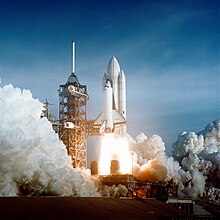Space age
The space age is the epoch of technological advances since the middle of the 20th century.
It is shaped by space research , space technologies and the influences resulting from these developments in many areas of daily life. The beginning of the space age is generally equated with the launch of the first Sputnik satellite on October 4, 1957. The term "Space Age" was used shortly after the end of the Second World War in Harry Harper's book Dawn of the Space Age and referred to the altitude record of the German V2 rockets in 1944 (184 km).
Beginnings
The space age began on June 20, 1944, when the A4 became the first man-made object to cross the border into space - more than 100 km altitude according to the definition of the Fédération Aéronautique Internationale . Missiles of this type were brought to the United States and the Soviet Union after the Second World War , where they were further developed independently of one another, which started the space race . On October 4, 1957, the launch of Sputnik 1 with an R-7 through the Soviet Union was possible. This was the world's first artificial satellite to move in orbit around the earth. It took him 98.1 minutes to complete one circuit and weighed 83 kg. The launch of Sputnik 1 ushered in a new era of politics, science, and technological achievement.
The space age was marked by the rapid development of new technologies in a neck-and-neck race between the United States and the Soviet Union. Other nations, for example China, pushed ahead with their own programs independently of this. Tremendous advances have been made in rocket science, materials science, computer science and many others, with much of the technology originally developed for space operations now found in everyday objects and with many new uses.
The space age reached a temporary climax with the Apollo program , which attracted the attention of much of the world's population. The Apollo 11 landing was seen by over 500 million people around the world and is widely recognized as one of the defining moments of the 20th century. Since then, public interest has largely shifted to other areas.
Spending on space programs stagnated during the 1990s when the remaining structures of the Soviet Union fell apart and NASA no longer had a direct competitor. International cooperations were established and reached the last milestone of the late 20th century with the construction of the International Space Station (ISS) in 1998.
Since then, more and more commercial companies have entered into participation in space ventures.
Current
At the beginning of the 21st century, the Ansari X-Prize competition was announced, which was supposed to facilitate the start for private space companies and was won in 2004 by Space Ship One . This makes Space Ship One the first spacecraft that was not financed by a government for the first time.
Today many countries have their own space programs. These range from collaborations to starting your own. There are also an enormous number of commercial and scientific satellites in orbit and many nations have plans for future manned missions.
chronology
| date | First ... | mission | People | country | rocket | Private company | government |
|---|---|---|---|---|---|---|---|
| June 20, 1944 | Artificial object in space (defined according to the Kármán line ) | Test flight | - N / A | Germany | V-2 | - N / A | Army research institute Peenemünde |
| October 24, 1946 | Images from space (105 km) | United States launched a V-2 missile from White Sands Missile Range in New Mexico | - N / A | United States | V-2 | - N / A | Joint Intelligence Objectives Agency |
| February 20, 1947 | Animals in space | United States launched a V-2 missile from White Sands Missile Range in New Mexico | - fruit flies | United States | V-2 | - N / A | Joint Intelligence Objectives Agency |
| 4th October 1957 | Artificial satellite | Sputnik 1 | - N / A | Soviet Union | |||
| 3rd November 1957 | Animal in orbit | Sputnik 2 | Laika (dog) | Soviet Union | |||
| 2nd January 1959 | Flyby maneuvers on the moon | Luna 1 | - N / A | Soviet Union |
See also
literature
- Harry Harper: Dawn of the Space Age . Sampson Low, Marston, & Co., London 1946, OCLC 560575218 .
- Remembering the Space Age. Proceedings of the 50th Anniversary Conference - Germans and Nazis, Mythmaking in Russia, American Culture and Music, Heinlein Influence, Apollo, Chinese Program . Smashwords Edition, Los Gatos 2012, ISBN 978-1-4660-2086-3 (English, books.google.de - reading sample).
Web links
- 50 Years of the Space Age: The United Nations is celebrating International Space Week 2007
- The Space Age Begins. - Oct. 4, 1957 - Sputnik, the Dawn of the Space Age.
Individual evidence
- ^ A Dictionary of the Space Age . JHU Press, 2010, ISBN 978-0-8018-9504-3 , pp. 187 ( books.google.de ).

